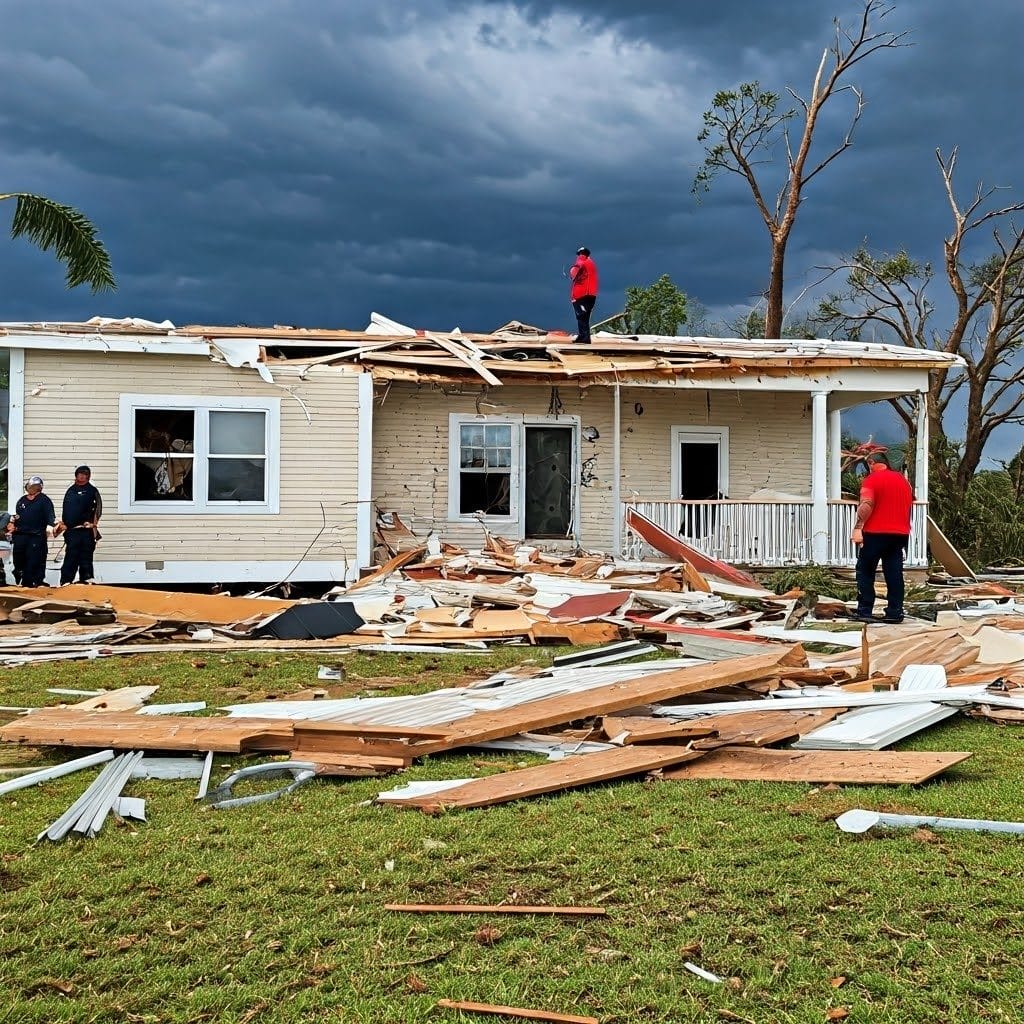North Florida is no stranger to unpredictable storm activity. From tropical depressions to full-force hurricanes, the season often brings high winds, heavy rainfall, and storm surges that can overwhelm even well-prepared communities. While residents can’t control the weather, they can control how ready their homes and insurance claims are when a storm hits. Preparation not only reduces damage but also speeds up recovery once the skies clear.
As a restoration and remodeling contractor with decades of combined experience in emergency response, First Coast Contracting has seen firsthand the difference preparation makes. Our crews have helped homeowners recover from flooding, roof failures, and structural damage. The homes that withstand storms better aren’t always the largest or newest—they’re the ones where owners took time before the season to safeguard their property and their paperwork.
Table of Contents
Strengthening Your Home Against Storm Damage
One of the most effective steps you can take before a storm is reinforcing your home’s exterior. This includes roofing, windows, doors, and vulnerable structural components.
A roof inspection should be at the top of your list. Loose shingles, worn flashing, or clogged gutters can all create openings for water intrusion. Once water penetrates, it can quickly spread through ceilings, walls, and flooring. Having a qualified contractor check for weak points and seal gaps can prevent thousands of dollars in repairs later.
Windows and doors are another critical area. Impact-resistant glass is ideal, but if your home doesn’t have it, invest in storm shutters or custom-fit plywood panels. Garage doors are especially prone to wind pressure failure. Bracing kits can reinforce existing doors and reduce the risk of collapse.
Don’t forget the home’s perimeter. Trim back large tree branches that could snap and damage the roof or siding. Inspect fences, sheds, and outdoor equipment to make sure they’re secured. Flying debris is one of the most common causes of storm damage.
Protecting Your Home’s Interior
Storm preparation isn’t just about what’s visible from the outside. Flooding and power outages create interior risks that can be minimized with advance planning.
If your home sits in a flood-prone zone, elevate critical systems like HVAC units, water heaters, and electrical panels where possible. Use waterproof storage bins for important belongings, especially documents and electronics. Sandbags and water diversion barriers can help redirect floodwater away from entry points.

Power outages are nearly guaranteed during severe storms. Surge protectors safeguard appliances and electronics from sudden power restoration. Backup generators, whether whole-house or portable, keep essentials running. If you choose a portable generator, remember to run it outside and away from windows to prevent carbon monoxide buildup.
It’s also wise to prepare for the possibility of extended displacement. Store at least a week’s supply of water, shelf-stable food, batteries, and medical supplies in a safe, accessible location. Think about pets as well—food, carriers, and vaccination records should be ready to go if evacuation becomes necessary.
Understanding Your Insurance Coverage
Many homeowners only discover the limits of their insurance coverage after a storm. Reviewing your policy before the season begins ensures you’re not caught off guard.
Standard homeowners’ insurance often excludes flood damage, which requires a separate policy through the National Flood Insurance Program (NFIP) or private insurers. Windstorm coverage may also be separate, depending on your location. Take time to read through your declarations page, noting deductibles for hurricane or wind claims, which are often higher than standard deductibles.
Contact your insurance agent with specific questions. Clarify whether additional living expenses (ALE) are covered if you’re forced out of your home during repairs. If your home has recent upgrades—such as a new roof or remodeled kitchen—make sure your policy reflects the increased value. Outdated coverage can leave you underinsured.
Documenting Your Property Before the Storm
Insurance claims are significantly easier when you have proof of your home’s condition before the storm. Documenting property is one of the most overlooked but powerful preparation steps.
Take clear photos and videos of the interior and exterior of your home. Capture each room, major appliances, and personal valuables. For items with receipts or appraisals, store copies digitally. Cloud storage is safest, as paper records may be lost if your home sustains water damage.
For homeowners with large properties or outbuildings, consider creating an inventory spreadsheet. List each item’s description, purchase date, and estimated value. While tedious, this can speed up claims dramatically when adjusters need itemized details.
Preparing for the Claims Process
Even the best-prepared homes can sustain damage, so it’s important to be ready for the insurance process itself. Knowing how to navigate claims reduces stress and accelerates recovery.
The first step after a storm is to ensure your safety. Once it’s secure to re-enter your property, take photos of all visible damage before making temporary repairs. Insurance adjusters need to see evidence, and photos taken right away hold the most weight.
That said, do not wait to protect your home from further damage. Insurers require homeowners to mitigate additional loss. Tarping a roof, boarding broken windows, or shutting off water to a burst pipe are all considered necessary protective actions. Keep receipts for any emergency materials purchased—these are often reimbursable.
When filing a claim, provide as much detail as possible. Include your documented pre-storm inventory, receipts for temporary repairs, and photos of new damage. Be prepared for adjusters to schedule inspections, and make notes of everything discussed. A dedicated claim diary can help keep dates, names, and conversations organized.
Coordinating With Contractors After the Storm
The period immediately following a storm is often chaotic. Contractors and restoration companies receive an influx of calls, and demand may exceed supply. Having a plan for how to select and work with a contractor reduces delays.
Look for licensed, insured companies with local experience. Out-of-town “storm chasers” often arrive in damaged communities offering quick fixes, but many leave before jobs are completed or warranties can be honored. Check credentials and ask for references.

Establish clear communication about timelines, scope of work, and coordination with your insurance adjuster. Reputable contractors often work directly with insurers to ensure required documentation is submitted. This avoids misunderstandings and prevents delays in approval.
If your home requires major restoration, prioritize structural safety first—roofing, foundation, and electrical. Cosmetic improvements like drywall finishing or painting can follow once the home is secure and livable.
Staying Ready Year After Year
Storm preparation isn’t a one-time project. North Florida homeowners should treat it as an ongoing process. After each season, review what worked and what could be improved. Did flood barriers hold? Was your generator sufficient? Were claims processed smoothly, or were there gaps in documentation?
Regular maintenance between seasons keeps your home ready. Schedule roof and HVAC inspections annually. Test sump pumps, check window seals, and replace weatherstripping as needed. Each step you take before the season lessens the chance of costly surprises when the next storm arrives.
Final Thoughts
Storm season in North Florida brings challenges every year, but preparation gives homeowners control over how well their homes and insurance claims withstand the impact. By reinforcing exteriors, safeguarding interiors, reviewing insurance coverage, documenting property, and understanding the claims process, you position yourself for faster recovery.
The effort you put in before the first storm alert can mean the difference between minor inconvenience and long-term displacement. Preparation may not prevent the storm, but it ensures you and your home are ready to face it with resilience.


